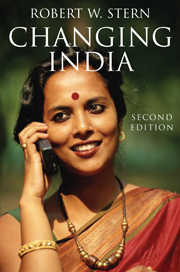Book contents
- Frontmatter
- Contents
- List of maps and tables
- Preface to the second edition
- Glossary
- Introduction: Change, the societies of India and Indian society
- Part I The changing countryside
- Part II Change from above
- Appendix One Major political events in the related histories of British imperialism and Indian nationalism, 1858–1947
- Appendix Two Major political events in the history of the Indian Union, 1947–2002
- Notes
- Guide to further reading
- Index
Appendix Two - Major political events in the history of the Indian Union, 1947–2002
Published online by Cambridge University Press: 18 April 2011
- Frontmatter
- Contents
- List of maps and tables
- Preface to the second edition
- Glossary
- Introduction: Change, the societies of India and Indian society
- Part I The changing countryside
- Part II Change from above
- Appendix One Major political events in the related histories of British imperialism and Indian nationalism, 1858–1947
- Appendix Two Major political events in the history of the Indian Union, 1947–2002
- Notes
- Guide to further reading
- Index
Summary
1947 Indian independence. Congress led by Jawaharlal Nehru becomes India's ruling party. The subcontinent is partitioned. An independent Pakistan, of two wings on India's east and northwest borders, comes into being.
1948 War in Kashmir. Mahatma Gandhi is assassinated by a Hindu militant.
1950 The secular, quasi-federal constitition of the Republic of India is promulgated.
After the death of Sardar Vallabhbhai Patel, Nehru becomes head of the Congress Party organization as well as prime minister.
1952 First general elections for parliament and state legislative assemblies establish the pattern of Congress's “one-party dominance.”
States begin to pass and enforce land reform legislation
1953 The formation of “linguistic states” begins with the creation of a Telegu-speaking Andhra Pradesh.
1955 The first of the major Hindu Code bills becomes law. The Marriage Act.
1957 India's planned industrialization begins in earnest under the Second Five Year Plan.
In the second general elections, a Communist Party government is elected in Kerala.
1959 Nehru uses constitutional provision of “President's Rule” to dismiss Kerala's elected government.
Panchayati raj institutions make their first appearance.
1961 The Indian Army “liberates” Goa from Portuguese rule.
1962 The third general elections confirm Congress's dominance. War with China.
1964 Jawaharlal Nehru dies; he is succeeded by Congress stalwart, Lal Bahadur Shastri.
1965 “Short-sharp” war with Pakistan. A truce mediated by the Soviet Union in 1966.
1966 Lal Bahadur Shastri dies. To succeed him, the Congress “syndicate” chooses Nehru's daughter, Indira Gandhi.
- Type
- Chapter
- Information
- Changing IndiaBourgeois Revolution on the Subcontinent, pp. 220 - 223Publisher: Cambridge University PressPrint publication year: 2003



